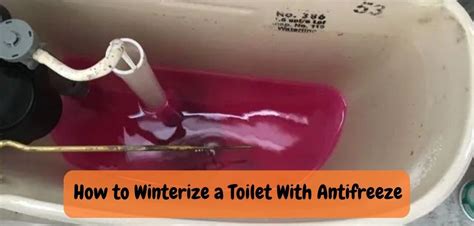How To Winterize Toilets
Ronan Farrow
Apr 03, 2025 · 3 min read

Table of Contents
How to Winterize Toilets: A Complete Guide for Protecting Your Plumbing
Winterizing your home is crucial to prevent costly plumbing issues from freezing temperatures. While many focus on pipes and faucets, the toilet often gets overlooked. Ignoring your toilet during winterization can lead to cracked bowls, damaged internal mechanisms, and expensive repairs. This comprehensive guide will walk you through the essential steps to winterize your toilets effectively and protect your plumbing system from winter's harsh conditions.
Understanding Why Toilets Need Winterization
Before diving into the how-to, let's understand why winterizing your toilets is so important. When temperatures plummet below freezing (0°C or 32°F), the water in your toilet tank and bowl can freeze. This expansion of freezing water can cause significant damage:
- Cracked Toilet Bowl: The pressure from expanding ice can crack the porcelain, leading to leaks and the need for a costly replacement.
- Damaged Internal Components: Freezing water can damage the flapper, fill valve, and other internal mechanisms, rendering your toilet unusable.
- Water Supply Line Freeze: The water supply line leading to the toilet is also vulnerable to freezing, cutting off the water supply entirely.
Essential Steps for Winterizing Toilets
The process of winterizing your toilet depends on whether you're winterizing your entire home or just protecting your toilet while you are away for a short period.
For Long-Term Winterization (Emptying the Toilet):
This method is best for homes left unoccupied throughout the winter.
- Turn Off the Water Supply: Locate the shut-off valve for your toilet (usually behind or under the toilet) and turn it clockwise to stop the water flow.
- Flush the Toilet: Flush the toilet several times to completely empty the tank and bowl.
- Remove Remaining Water: Use a sponge or towel to soak up any lingering water in the tank and bowl.
- Add RV Antifreeze (Optional): Pour a cup or two of RV antifreeze into the bowl and tank. This helps prevent any remaining water from freezing. Note: Do not use automotive antifreeze; it is toxic.
- Open the Tank Lid: Leaving the toilet tank lid open allows for better air circulation, preventing moisture buildup.
For Short-Term Absence (Preventing Freezing):
If you're away for a short period and temperatures are only slightly below freezing, a less intensive method will suffice.
- Insulate the Pipes: Wrap the water supply line leading to the toilet with pipe insulation sleeves. This helps prevent freezing.
- Keep the Heat On (Low Setting): If possible, maintain a low level of heat in the house to prevent freezing.
- Keep Cabinets Open: Keeping the cabinet doors under the sink open can help prevent freezing.
Additional Tips for Winterizing Your Toilets
- Protect Exposed Pipes: Ensure all exposed water pipes leading to the toilet are properly insulated.
- Regularly Check for Leaks: After winterization, inspect your toilets regularly for any leaks. A small leak can cause significant problems.
- Consider a Heated Toilet Seat: A heated toilet seat can help prevent freezing in extremely cold climates.
Conclusion
Winterizing your toilets may seem like a small task, but it's a vital step in protecting your plumbing system from costly damage during the winter months. By following these simple steps and taking preventative measures, you can ensure your toilets remain functional and damage-free throughout the winter season. Remember to adjust the method based on the length of your absence and the severity of the winter conditions in your area. Proactive measures now can save you significant expenses and headaches later.
Featured Posts
Also read the following articles
| Article Title | Date |
|---|---|
| How Are Tractor Hours Calculated | Apr 03, 2025 |
| How Are Laundry Detergent Sheets Made | Apr 03, 2025 |
| How To Use Liquid Diamond Vape | Apr 03, 2025 |
| How To Watch Drive In Movie Without Draining Car Battery | Apr 03, 2025 |
| Henry Howe Grand Forks Nd | Apr 03, 2025 |
Latest Posts
-
How Did Brody Beaver Die
Apr 04, 2025
-
How Did Briana Sanchez Passed Away
Apr 04, 2025
-
How Did Brewster Spend His Millions
Apr 04, 2025
-
How Did Angelia Joiner Die
Apr 04, 2025
-
How Did Aaron Brown Pass Away
Apr 04, 2025
Thank you for visiting our website which covers about How To Winterize Toilets . We hope the information provided has been useful to you. Feel free to contact us if you have any questions or need further assistance. See you next time and don't miss to bookmark.
